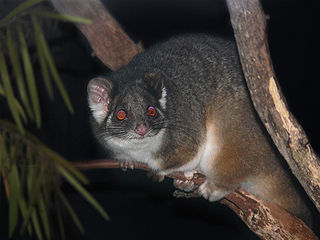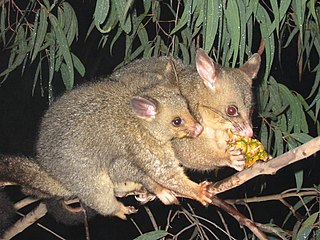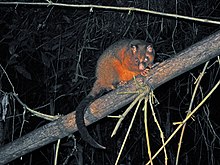
Phalangeriformes is a paraphyletic suborder of about 70 species of small to medium-sized arboreal marsupials native to Australia, New Guinea, and Sulawesi. The species are commonly known as possums, gliders, and cuscus. The common name "possum" for various Phalangeriformes species derives from the creatures' resemblance to the opossums of the Americas. However, although opossums are also marsupials, Australasian possums are more closely related to other Australasian marsupials such as kangaroos.

The common brushtail possum is a nocturnal, semiarboreal marsupial of the family Phalangeridae, native to Australia and invasive in New Zealand, and the second-largest of the possums.

The common ringtail possum is an Australian marsupial.

Poison shyness, also called conditioned food aversion, is the avoidance of a toxic substance by an animal that has previously ingested that substance. Animals learn an association between stimulus characteristics, usually the taste or odor, of a toxic substance and the illness it produces; this allows them to detect and avoid the substance. Poison shyness occurs as an evolutionary adaptation in many animals, most prominently in generalists that feed on many different materials. It is often called bait shyness when it occurs during attempts at pest control of insects and animals. If the pest ingests the poison bait at sublethal doses, it typically detects and avoids the bait, rendering the bait ineffective.

The scaly-tailed possum is found in northwestern Australia, where it is restricted to the Kimberley.

The greater gliders are three species of large gliding marsupials in the genus Petauroides, all of which are found in eastern Australia. Until 2020 they were considered to be one species, Petauroides volans. In 2020 morphological and genetic differences, obtained using diversity arrays technology, showed there were three species subsumed under this one name. The two new species were named Petauroides armillatus and Petauroides minor.

The short-eared possum is a species of marsupial in the family Phalangeridae, endemic to Australia. Found north of Sydney, New South Wales, on Australia’s eastern coast, the species was once classed under the mountain brushtail possum, its closest relative.

The brushtail possums are the members of the genus Trichosurus in the Phalangeridae, a family of marsupials. They are native to Australia and some small nearby islands. Unique among marsupials, they have shifted the hypaxial muscles from the epipubic to the pelvis, much like in placental muscles, meaning that their breathing cycle is more similar to the latter than to that of other non-eutherian mammals. In general, they are more terrestrially oriented than other possums, and in some ways might parallel primates.

The mountain brushtail possum, or southern bobuck, is a nocturnal, semi-arboreal marsupial of the family Phalangeridae native to southeastern Australia. It was not described as a separate species until 2002.

The Phalangeridae are a family of mostly nocturnal marsupials native to Australia, New Guinea, and Eastern Indonesia, including the cuscuses, brushtail possums, and their close relatives. Considered a type of possum, most species are arboreal, and they inhabit a wide range of forest habitats from alpine woodland to eucalypt forest and tropical jungle. Many species have been introduced to various non-native habitats by humans for thousands of years.

The northern brushtail possum is a nocturnal marsupial inhabiting northern Australia. The northern brushtail possum is sometimes considered a species; however, more often than not is considered a subspecies of the common brushtail possum.

The common brushtail possum was introduced from Australia to New Zealand, where it has become invasive and a major agricultural and conservation pest.

Myrsine australis, commonly known as māpou, red matipo, tīpau, and mataira is a species of shrub within the family Myrsinaceae. It is endemic to New Zealand, found throughout both the mainland and offshore islands.

The Arnhem Land tropical savanna is a tropical and subtropical grasslands, savannas, and shrublands ecoregion in Australia's Northern Territory.

Phaulacridium marginale is a small species of short-horned grasshopper in the family Acrididae. It is endemic to New Zealand where it is found in low elevation open habitat throughout North Island, South Island, Stewart Island and on many smaller islands.

Priscilla M. Wehi is a New Zealand ethnobiologist and conservation biologist. As at July 2021 she is an associate professor at the University of Otago and on the first of that month officially undertook the role of director of Te Pūnaha Matatini, a centre of research excellence in complex systems and data analytics. During the COVID-19 pandemic in New Zealand Te Pūnaha Matatini scientists have developed mathematical models of the spread of the virus across the country that influence the New Zealand government's response to the outbreak. In 2021 Wehi was awarded the Hill Tinsley Medal.
Wobbly Possum Disease is a fatal neurological condition of the brushtail possum, first reported in 1995. Symptoms include a stumbling gait, tremors, blindness, activity during the daytime, and falling from trees. The disease is believed to be caused by a virus.



















